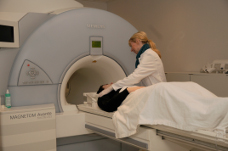Magnetic Resonance Imaging (MRI)
Author: Gesche Tallen, MD, PhD, Editor: Maria Yiallouros, Reviewer: Prof. Dr. med. Dr. h. c. Günter Henze, English Translation: Hannah McRae, Last modification: 2015/04/22 https://kinderkrebsinfo.de/doi/e2026
Magnetic resonance imaging (MRI) or magnetic resonance tomography (MRT) is a medical imaging techique that visualises detailed internal structures by taking cross-sectional pictures of a patient's body. Unlike X-ray or computed tomography (CT) techniques, MRI does not involve exposure to ionising radiation. It makes use of the electromagnetic energy in the cells of a patient's body.
MRI provides good contrast between the different soft tissues of the body. Therefore, it is preferred in imaging the brain, muscles, the heart, and cancers to other medical imaging techniques such as CT or X-rays.
During the procedure, the patient is laying in the so-called MRI machine. This machine produces a rotating magnetic field around the different tissues being scanned. The signals bouncing back from the tissue (resonance) are detected by a scanner, which records this information to construct an digital image of the scanned area of the body.
MRI can provide images of various views on the body, such as vertical (coronal plane), horizontal (axial plane), from the side (sagittal plane) and also of the blood vessels (MR-angiography).
For certain questions in childhood cancer diagnostics, for example after surgery, when doctors want to rule out remaining tumour tissue or to distinguish between tumour and scar tissue, the intravenous administration of a contrast media is necessary.
An MRI does not hurt. However, it takes a relatively long time and makes a lot of noise. Also, in order to obtain valid images, it requires the patient to not move during the procedure at all. Therefore, the patients are usually provided with ear-protectors. Also, younger children are usually sedated during the examination. In most large paediatric treatment centres, MRI facilities are equipped in a child-friendly manner, so that the experience of an MRI is as least stressful for young patients as possible.
The results of an MRI are usually interpreted by a paediatric radiologist. An MRI scan is usually only performed on children or teenagers (under 18 years of age) after an informed consent has been obtained by the parent or legal guardian.

